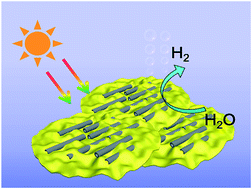Bio-inspired SiO2-hard-template reconstructed g-C3N4 nanosheets for enhanced photocatalytic hydrogen evolution†
Abstract
Building architectures to manipulate light propagation using a light-conversion matrix is one of the most competitive strategies to enhance photocatalytic performance. In this work, a bio-inspired SiO2 hard template with interconnected SiO2 with a one-dimensional structure was devised to enhance the visible light harvesting ability of g-C3N4, and the SiO2/g-C3N4 nanocomposite is cleverly synthesized via an in situ thermal polymerization method. Based on UV-vis diffuse reflectance spectrometry (UV-vis DRS) and finite difference time domain simulation (FDTD) measurements, it is found that the SiO2/g-C3N4 nanocomposite displays obviously enhanced visible light absorption and light-scattering when compared to pristine g-C3N4, suggesting it has highly enhanced light harvesting ability. As expected, SiO2/g-C3N4 displays a remarkable enhancement in photocatalytic H2 production when compared to bare g-C3N4. Such enhancement is attributed to the synergistic effect of g-C3N4 and SiO2 hard template microstructures. The SiO2 one-dimensional structure not only enhances light scattering to widen the visible-light absorption range and improve the utilization efficiency of solar energy, but it also increases the specific surface area of g-C3N4 by reducing its aperture size. This research has far-reaching implications for increasing the use of sunlight and improving the development of hydrogen energy.



 Please wait while we load your content...
Please wait while we load your content...